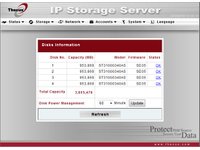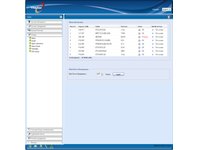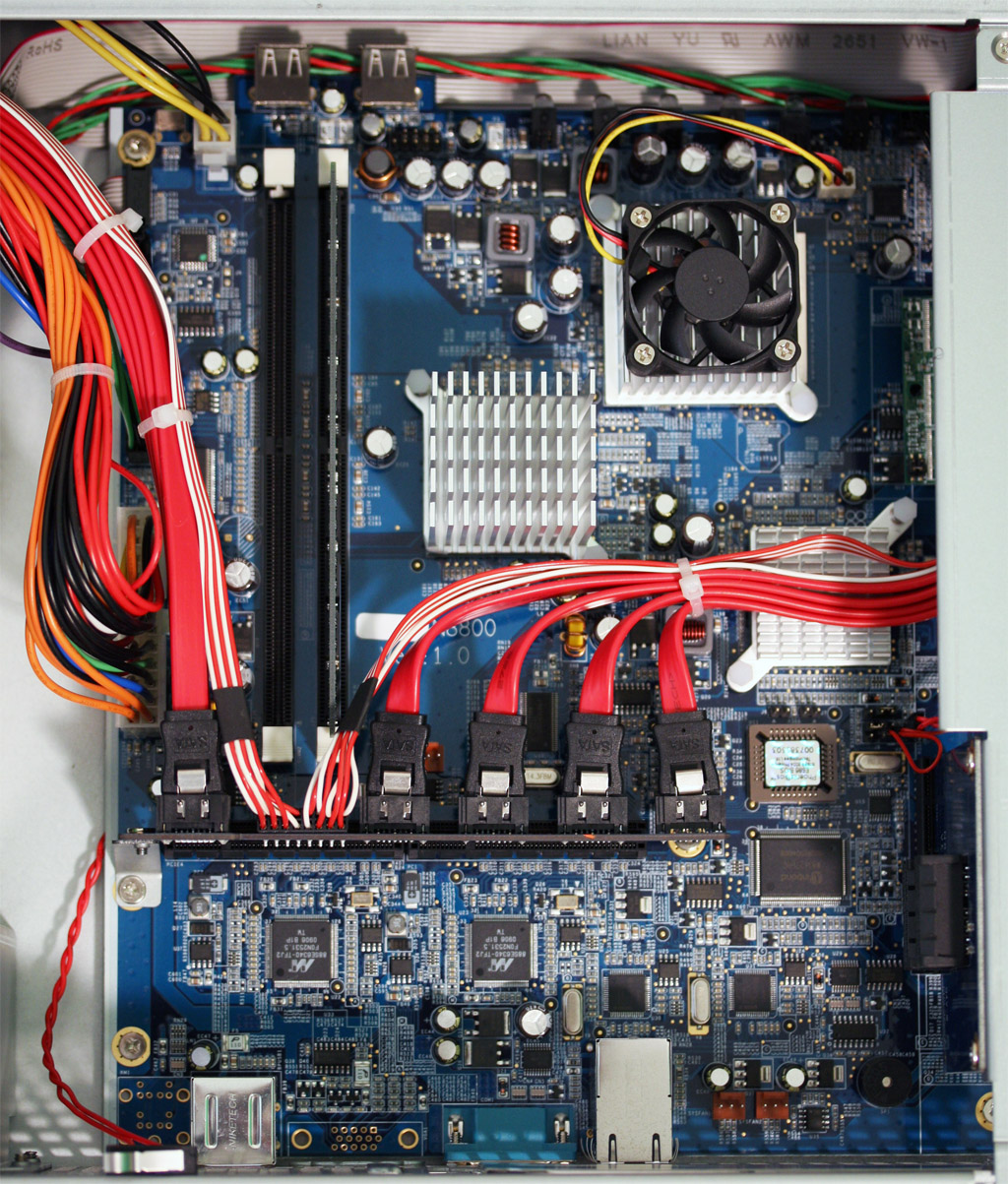Thecus N8800 NAS/SAN: Quick-Look
Setup
Configuration
Setting the N8800 up was fairly simply—after all, I had already been using the N5200 for more than a year. It was simply a matter of dropping in eight drives, connecting the bundled patch cable to the WAN port, and attaching both power cords (you need to used both power supplies, else the system’s alarm sounds). Power up, hit the device’s default IP, and start configuring the configuration utility, which resides on a motherboard-down DoM.


The interface of the config app was initially the same as the one used on Thecus’ N5200—a fact that we’ve seen some users complain about (personally, I thought it was easy to navigate and manipulate). However, there was recently an update published that phased in a new AJAX interface. It’ll take some getting used to, but its hierarchical layout is logical enough, and performance of the UI is reasonable.
Without question, this isn’t a piece of equipment you’re going to want to have running in an office environment. While it’s a good deal quieter than most of the rackmount servers I’ve ever heard, the N8800 still cranks out 54.5 decibels from three feet away, head-on. In contrast, the N5200 (armed with four 1TB drives at the same distance) generates 45.4 decibels.
Rubber, Meet Road
We’ve established that home users probably won’t be using this unit. We’ve established that you probably don’t want it running anywhere people who can hear actually need to get work done. This thing had better be full of features and fast, right?
Fortunately, it is on both accounts. I was able to write 4.86GB of benchmark folders from the N8800 to my Core i7-based workstation in 1:27. The same operation took 2:05 with the Thecus N5200 (as a brief refresher, the N5200 only has a 600 MHz Celeron M and 256MB of DDR memory backing it—it’s comparatively much less powerful).
Get Tom's Hardware's best news and in-depth reviews, straight to your inbox.
The appliance’s list of features reads like a compilation of business must-haves: Wake on LAN, UPS monitoring, build-in backup, scalability out to additional units, RAID 0/1/5/6/10 support, auto-rebuild, hot-swap, hot-spare, programmable spin-down for power savings, load balancing, link fail-over—to be honest, most of this is overkill for my application, and really needs to be used in an environment with more than two or three users (twenty or thirty would be a better starting point, I imagine).
However, at the end of the day, the 55+ MB/s I’m able to get out of Thecus’ N8800 is more than ample for streaming multiple Blu-ray quality movies around the house (in comparison, the N5200’s RAID 5 array was good for just under 40 MB/s). And with eight drive bays (plus the option to stack additional units), I think I’m taken care of for capacity, too.
-
excalibur1814 Nice article. I'm now off to see the price of these units as I need some serious storage due to possibly storing all my dvds etc.Reply -
thearm "Nice article. I'm now off to see the price of these units as I need some serious storage due to possibly storing all my dvds etc."Reply
LOL How does one get voted down for that? I'm planning on doing the same thing. The net has some strange folks. -
huron Nice. I've been looking at NAS/SAN products for my home for a similar setup to accompany the HTPCs I am building.Reply
Now, just have to check the price and convince the wife that it's "necessary." -
Spanky Deluxe Ouch. Costs about £1200 here in the UK. While its certainly a very nice solution, the more budget conscious might want to invest in a 4U rackmount case, a cheap computer setup with gigabit ethernet and a couple of 4 port SATA cards. Something like that can be had for about £250 before drives (£50 for case, 2x£40 for controllers, £120 for Intel Ion Mobo/Processor + RAM). Obviously not nearly as nice and would need some knowledge of Linux for a decent setup but doable.Reply -
blarger Hey gueys I needed a car to get to work so I started looking around at commuter cars, they worked but I wasnt happy with them so I bought a Porsche 911. It's not really made for the commuter market but I'm going to tell you commuters looking for commuter cars all about it.Reply
It's overpriced, breaks a lot and of course the repair bills are more than what you'd call high. But whatever just wanted to let you know that this site footed the bill for my awesome extravagance so lolol. -
blarger damn wish I coulda worked in that this thing pretty much requires a rackmount setup into the car analogy.Reply


